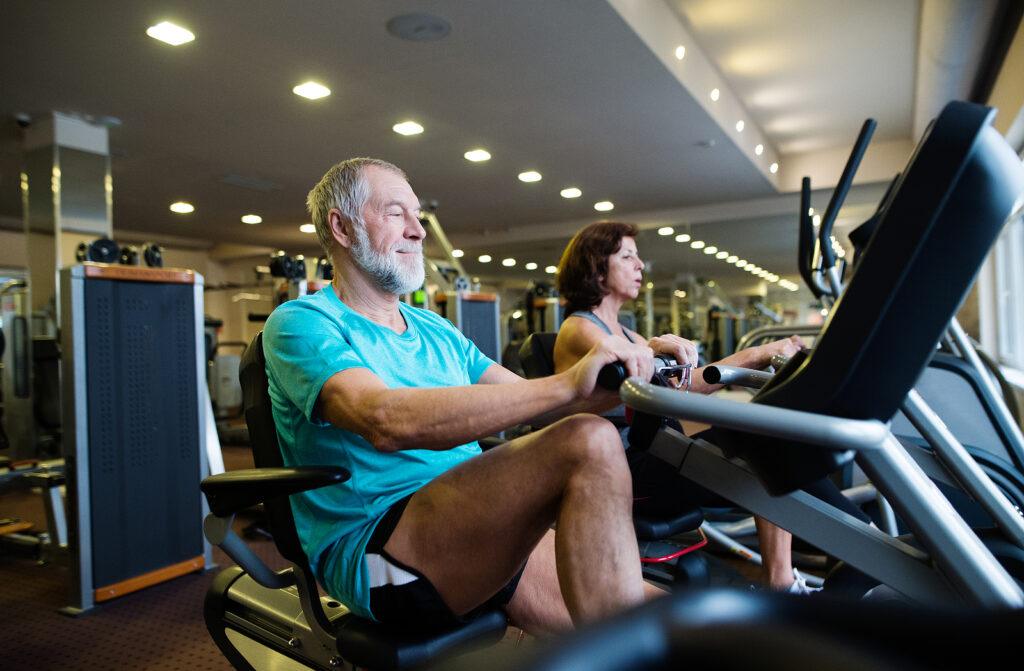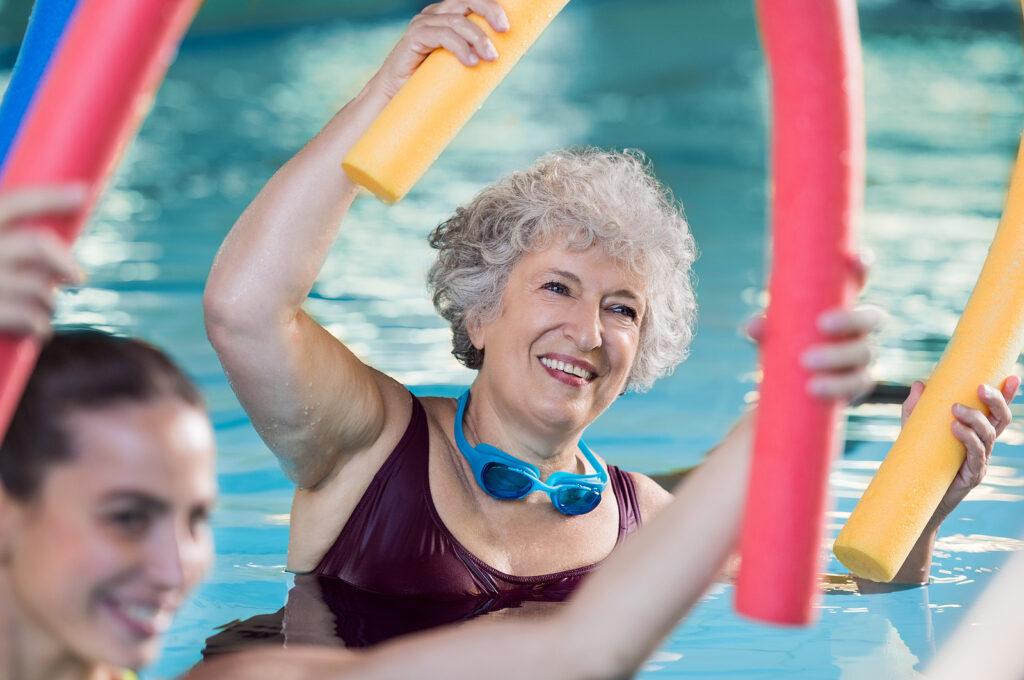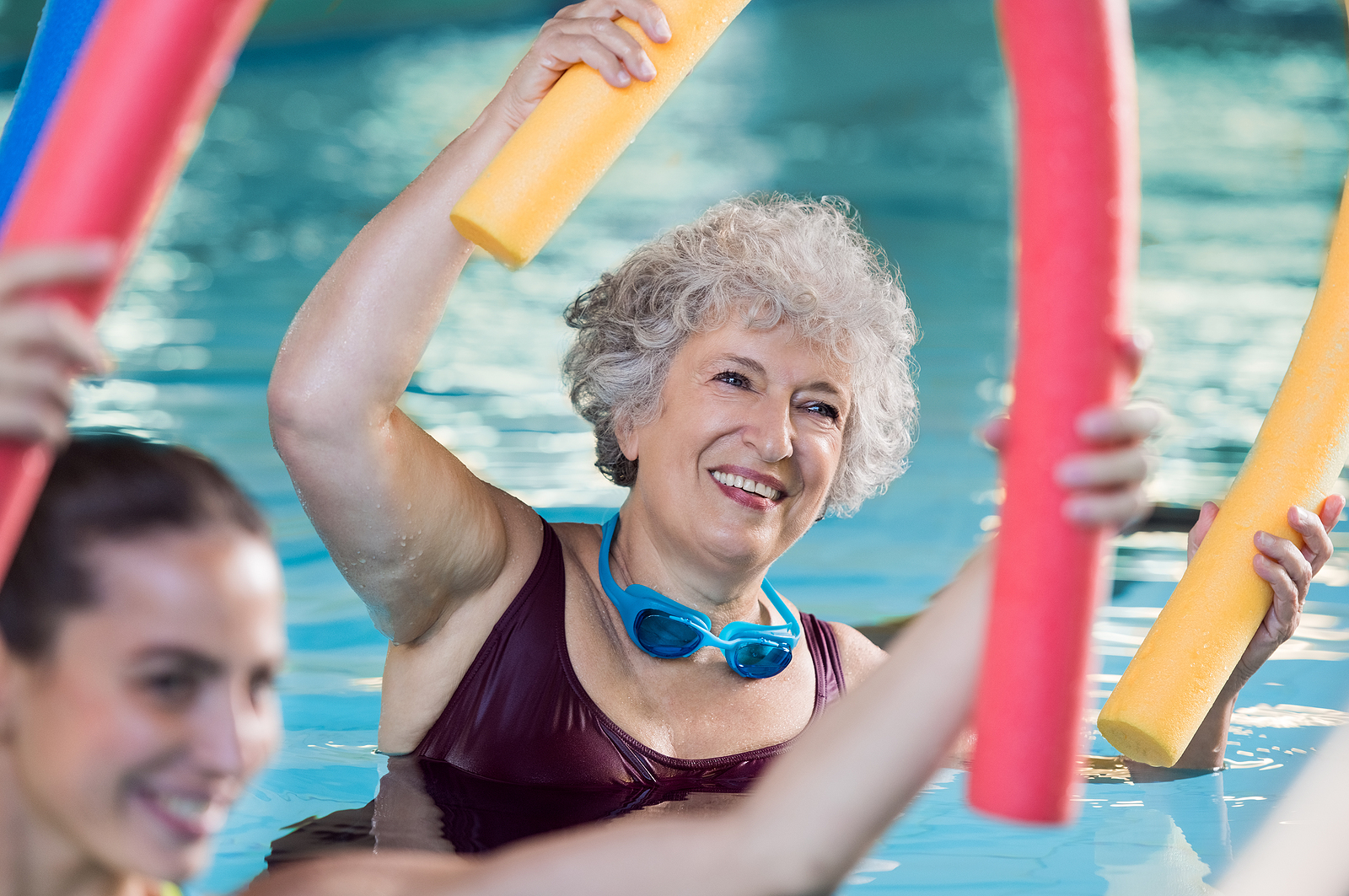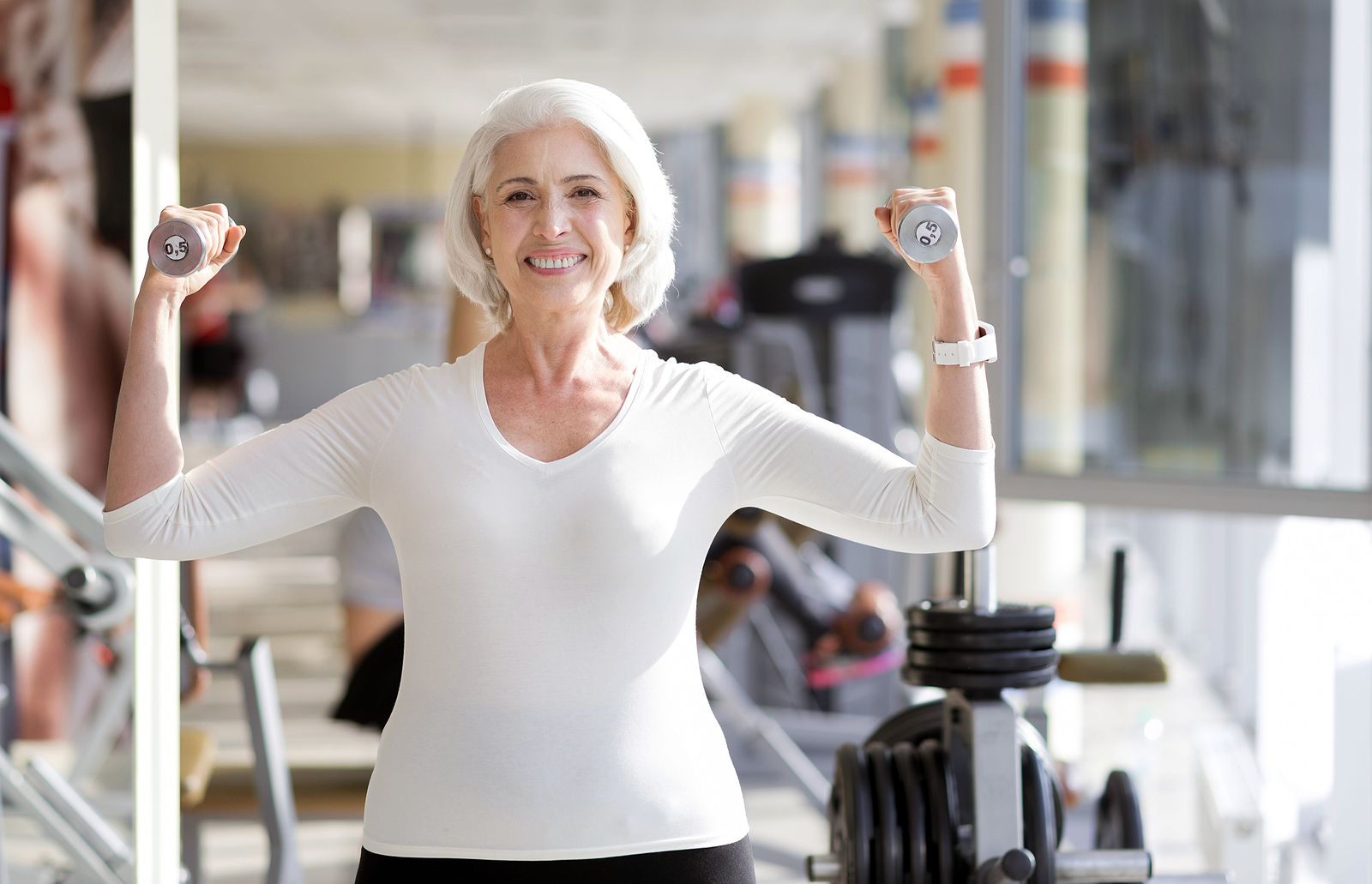We often stress the importance of seniors performing strengthening exercises in order to maintain their strength and mobility, but it’s just as important for seniors to get their cardio in too.
And that’s because seniors can reap all the same benefits from cardio exercise that the younger folks can.
We’re talking improved heart health, higher energy levels, improved mood… the list goes on.
There’s no denying the importance of regular cardiovascular exercise, but it’s also true that it can be more challenging for seniors to find safe and comfortable ways to get this exercise in.
Lack of equipment, mobility deficits, and safety concerns can certainly be obstacles, but there are many cardio exercises that are both safe and effective for seniors.
In this article, we’ll go over the benefits of cardio exercises for seniors and share some low-impact, senior-friendly cardio workouts to help you stay active and feel your best.
Why Cardio Is Important for Seniors
Cardiovascular (cardio) exercise refers to any activity that raises your heart rate and keeps it elevated for a sustained period.
It strengthens the heart, lungs, and muscles, and it’s an excellent way to improve overall health.
It’s important for folks of all ages, but here are a few key benefits of cardio exercises for seniors:
- Heart Health: Cardio strengthens the heart, improving circulation and reducing the risk of heart disease and stroke.
- Increased Energy: Regular cardio helps improve stamina, making everyday activities easier and less tiring.
- Weight Management: Cardio burns calories, which helps with maintaining a healthy weight.
- Improved Mobility: By keeping the muscles and joints active, cardio helps maintain mobility and balance, reducing the risk of falls and improving independence in the home.
- Mental Health Boost: Exercise releases endorphins, which can help improve mood and help reduce stress, anxiety, and depression.
Safety Tips Before Starting Cardio
Before beginning any new cardio routine (especially if you have underlying health issues or have been inactive), it’s important to consider a few safety precautions:
- Consult Your Doctor: Always check with your doctor before starting a new exercise routine, particularly if you have any pre-existing cardiac conditions.
- Warm Up: Start each session with a light warm-up, like gentle walking or marching in place, to get your muscles ready for exercise.
- Start Slowly: Ease into your cardio routine by starting with shorter, lower-intensity sessions and gradually increasing as your fitness improves.
- Stay Hydrated: Keep water on hand and take small sips throughout your workout to stay hydrated.
- Listen to Your Body: If you feel pain, dizziness, or shortness of breath, stop immediately and consult your doctor.
6 Senior-Friendly Cardio Exercises
Here are some low-impact cardio exercises that are safe and effective for most seniors.
These exercises can be done at home, at a gym, or even outdoors, and they can be adapted to suit any fitness level.
1. Walking
Walking is one of the best and simplest forms of cardio for seniors.
I mean it’s low-impact, easy to do, and can be done almost anywhere and you don’t need any equipment to do it.
Start with a slow, comfortable pace and gradually increase your speed as you warm up. The goal is to walk at a comfortable speed and be able to have a conversation if you had to.
It’s ok to use a cane or walker and don’t be afraid to ask a caregiver to walk with you.
A good goal would be to walk for at least 30 minutes a day, most days of the week.
You can walk in your neighborhood, at a park, or even indoors in your home if you have enough space. Treadmills are also acceptable, as long as you feel safe using one.
Walking is great because it improves cardiovascular health, strengthens leg muscles, and enhances balance and coordination.
In other words, it’s easily one of the best cardio exercises out there for seniors.

2. Cycling
Cycling is another low-impact cardio exercise that’s gentle on the joints, making it ideal for seniors with arthritis or joint pain.
You can use an outdoor cycle if your mobility and balance are up to it, but a stationary bike at home (or a at the gym) is likely the safer bet.
All stationary bikes are pretty low-impact, but if your joints are especially achy, you might prefer using a recumbent bike, which puts even less pressure through your hips and knees.
Start with a low level of resistance and try to build up to riding 20-30 minutes at a time.
Once you can ride this long comfortably, gradually start increasing the resistance level.
Overall, cycling can be a great low-impact cardio exercise. It can effectively strengthen the legs, improve cardiovascular health, and help with joint mobility.
3. Swimming or Water Aerobics
This won’t be for all seniors, but if you access to a pool, it’s definitely worth a try because the benefits greatly outweigh the hassle of getting changed and whatnot.
Water-based exercises like swimming and water aerobics are perfect for seniors because the water provides support for the joints while offering resistance for a good workout.
This allows seniors the ability to perform movements and exercises that they would otherwise be unable to perform.
Water aerobics are especially good for seniors dealing with arthritis, but again, this stuff is good for everyone.
You can swim laps at your local pool or join a water aerobics class designed for seniors.
Either way, aim for 20-30 minutes of water exercise as many days a week as possible.
Swimming and water aerobics can both be used to greatly improve cardiovascular health, increase strength and flexibility, and provide a full-body workout with minimal strain on the joints.

4. Dancing
Dancing is a fun and social way to get your heart rate up, and you don’t need to be a pro to enjoy the benefits.
You can even dance in your living room, I’ve seen it done.
I had a patient once who was an avid dancer and her goal was to be able to go dancing with her husband again.
We worked on some balance and conditioning exercises and I’m happy to say she eventually reached her goal – she even taught me a few moves while we were at it.
And if you’ve ever danced before, you know how much of a workout it can be.
Put on your favorite music and move to the rhythm!
You can follow along to an online dance video, take a dance class, or simply freestyle. Start with 15-20 minutes and work your way up to half an hour as you feel more comfortable.
Dancing’s great for improving cardiovascular health, but it’s also a fun way to improve balance and coordination.
5. Low-Impact Aerobics
Low-impact aerobics are designed to raise your heart rate without putting too much stress on your joints.
You can follow along with a senior-friendly aerobics video or attend a local class.
You can also start with a basic routine from home though.
Here’s an example of a low-impact workout that could be used to get your cardio in:
- Heel raises x 15
- Mini-squats x15
- Leg kick to the side x15 (each leg)
- Leg kick backwards x15 (each leg)
- Marching in place x15 (each leg)
Perform the above circuit from start to finish 3x, resting as needed between sets.
This is just a quick example, there are tons of other bodyweight exercises that could be used, including plenty of great trunk and arm exercises to get the whole body involved.
6. Chair Exercises
For seniors with limited mobility or balance issues, chair exercises can be a great way to stay active while remaining seated.
Many chair-based cardio routines involve moving your arms and legs to get your heart rate up and they can be quite effective.
Sit in a sturdy chair and perform movements like marching in place, arm circles, leg extensions, trunk rotations, toe taps, etc.
You can find tons of chair exercise videos online or follow a class at a local gym.
Chair exercises are safe and accessible, allowing seniors with mobility issues the ability to exercise in a safe manner.
How Often Should Seniors Do Cardio?
Well, according to the CDC, folks 65 years old and older should be getting 150 minutes of moderate intensity cardio exercise each week or 75 minutes of vigorous intensity.
FYI, “moderate intensity” exercise is any activity that’s equivalent to brisk walking in difficulty and “vigorous intensity” would be the equivalent of jogging or running.
150 minutes of cardio each week might sound like a tough goal, but it’s more doable than you think.
If we break this down, this is really 30 minutes of exercise, 5x/week.
Thirty minutes a day is getting more doable, but the good news is that we can even break this up into smaller chunks if we have to.
So, if 30 minutes of continuous exercise is too much, feel free to break it up into 2×15 minute sessions or even 3×10 minute sessions.
When it comes to reaping the benefits of cardio, you don’t have to do all 30 minutes at once.
If you’re just starting, it’s okay to begin with shorter sessions and gradually work your way up to this goal.
Measuring Intensity of Exercise
Before we wrap things up here, I want to touch on the issue of intensity.
When doing cardio, it’s helpful to have an idea as to how hard you’re pushing yourself at any given time.
This can help determine whether you’re falling more in the “moderate” or “vigorous” category when trying to reach your weekly goals, but it can also be used as a measure of progress.
The easiest way to subjectively measure your progress is to think of a number scale from 0 to 10.
Ask yourself, if “0” is sitting on the couch watching tv and “10” is running as fast as you can, how hard are you working?
- If you’re somewhere in the 5-7 range, you’re performing a moderate intensity exercise
- If you’re at an 8 or higher, you’re performing a vigorous activity
Another easy way to tell is the talk test – if you can talk comfortably during exercise, you’re at a light to moderate intensity level; if you’re too short of breath to talk comfortably, you’re at a vigorous level of intensity.
Keep in mind, intensity level is subjective and will depend on your fitness level.
Most seniors will likely be more comfortable with moderate intensity cardio exercises, but that doesn’t mean more vigorous activities are off the table.
Final Thoughts
Cardio exercises are just as important for seniors as they are for any other age group.
And with so many low-impact options available, it shouldn’t be that hard to find an activity that suits your fitness level and lifestyle.
Sure, it’s easier if you have access to gym equipment at your home or have a gym membership, but there are plenty of exercise options that don’t require equipment.
As mentioned earlier, walking is the perfect exercise for seniors because it’s effective and can be done just about anywhere.
Whether you enjoy walking, swimming, dancing, or chair exercises, the key is to stay consistent and find something you enjoy.
Always remember to consult your doctor before starting a new exercise routine, and most importantly, listen to your body.
If anything hurts, please stop and consult a professional.
I hope you found this article helpful and if you have any comments, questions, or suggestions for other great senior-friendly exercises, please leave ’em below.



